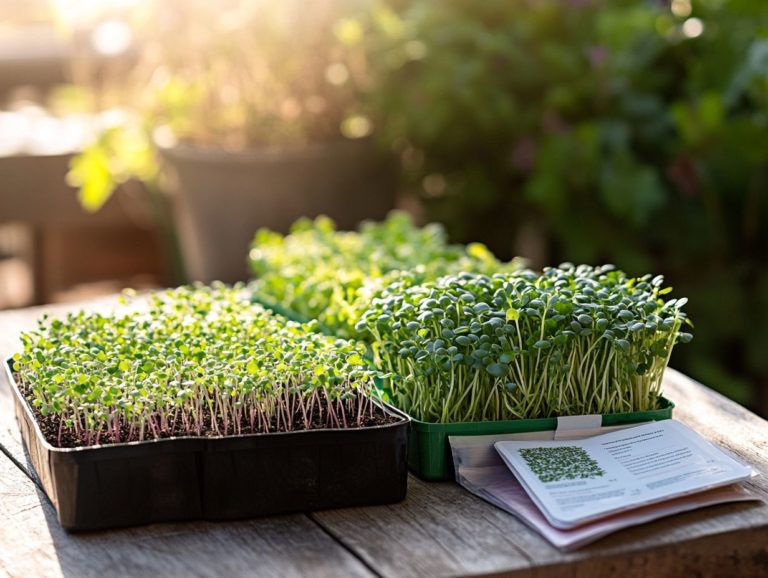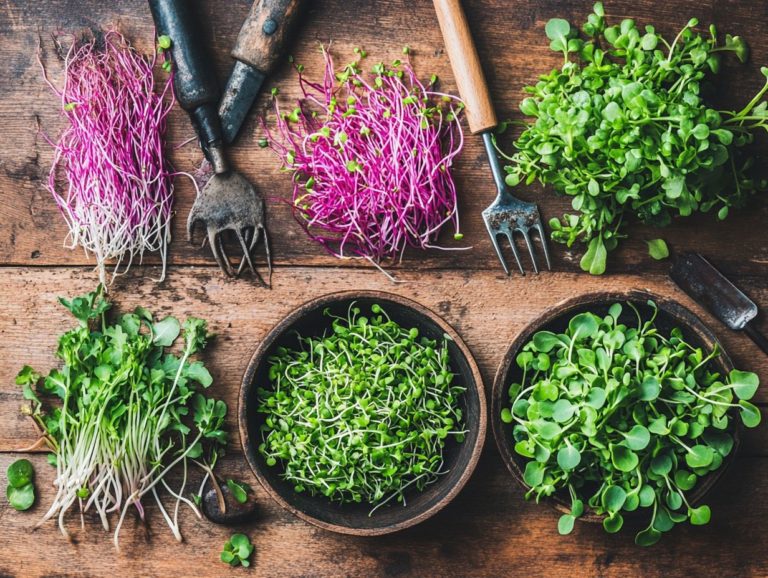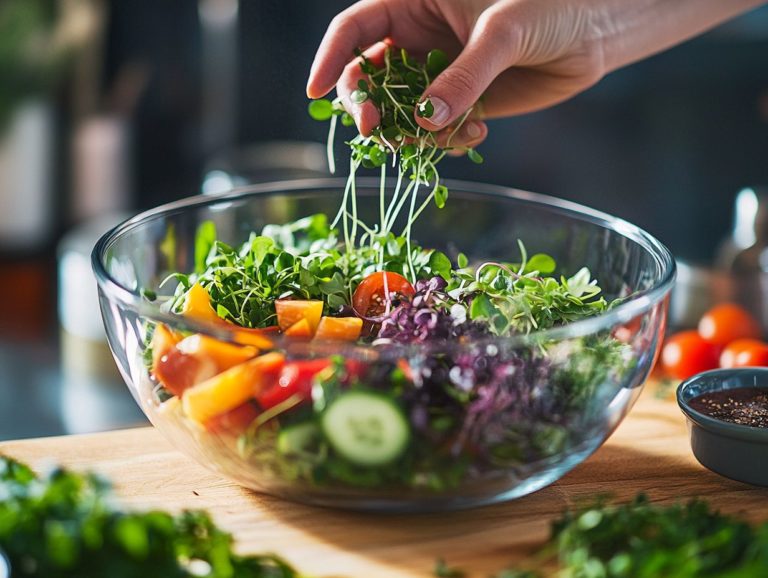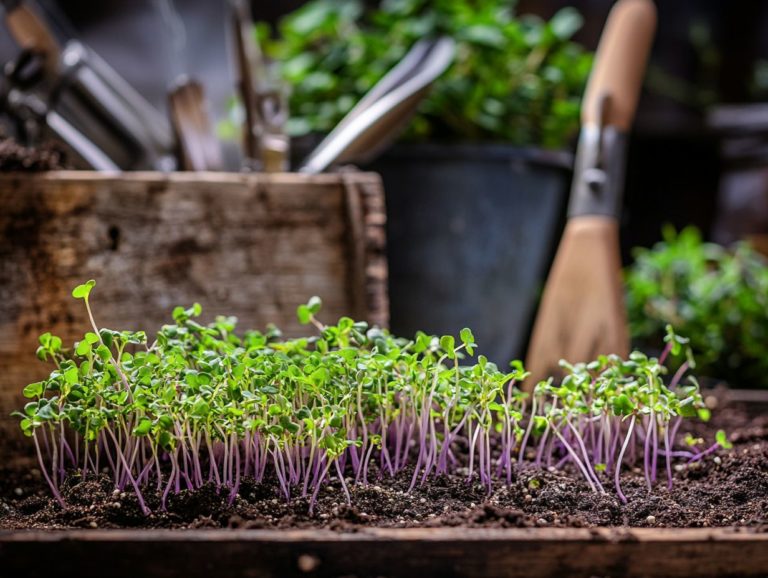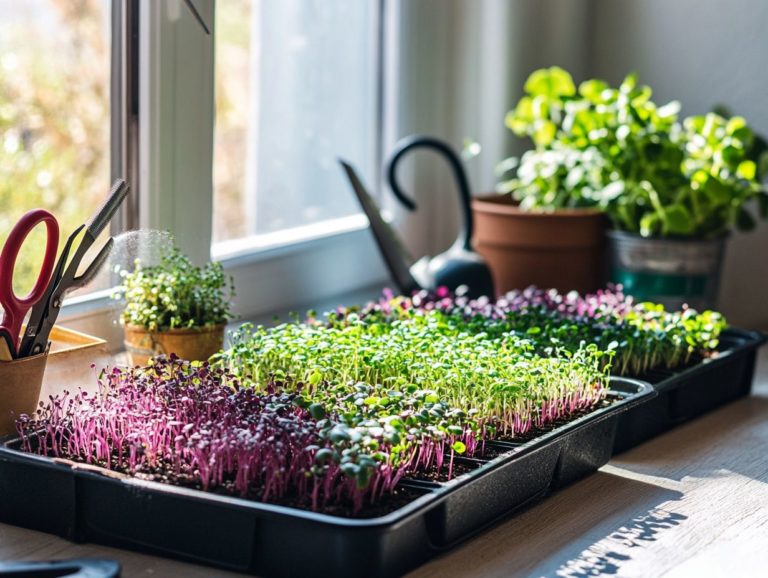What Microgreens Are Best for Salads?
Microgreens are petite, nutrient-dense plants that can elevate your salads to a new level. These fast-growing microgreens bring vibrant colors and distinct flavors while offering a treasure trove of health benefits, especially appealing to health-conscious consumers.
Creative recipes await to inspire you, encouraging the incorporation of these little powerhouses into your meals. Get ready to take your salads to the next level!
Contents
Key Takeaways:
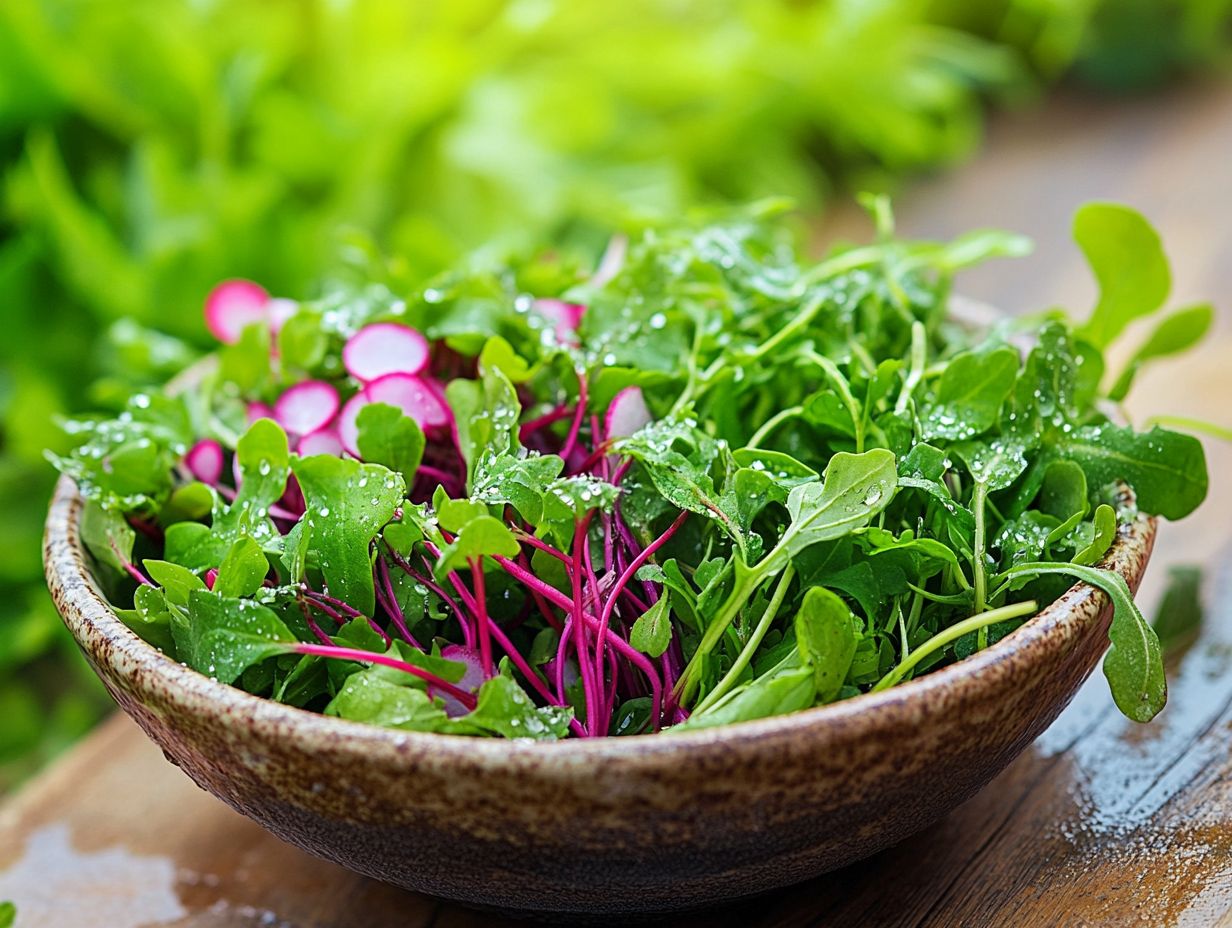
Microgreens are tiny, nutrient-packed versions of mature plants that are perfect for adding a burst of strong flavor and nutrition to salads, making them a staple in fine dining.
When choosing microgreens for salads, consider factors such as taste, color, and texture. Some top options include peppery arugula, radish, and broccoli microgreens, which are all notable for their high nutrient content. If you’re interested in incorporating microgreens into your juice, check out which microgreen varieties are best for juice.
- Growing your own microgreens for salads is easy and cost-effective. Follow a simple step-by-step guide and get creative with recipes and ideas to elevate your salad game.
What are Microgreens?
Microgreens are delightful little plants packed with nutrients that have gained popularity among health-conscious consumers since their California debut in the 1990s. These fast-growing wonders include varieties like peppery arugula, zesty mustard, and kale, typically harvested just after the first true leaves emerge.
Known for their concentrated nutrients and bold flavors, microgreens elevate salads and gourmet dishes, making them a staple in fine dining venues that focus on seasonal eating. Options such as sweet pea microgreens, nutrient-rich broccoli, earthy beets, and crunchy sunflower provide nutritious options that help combat malnutrition.
Wheatgrass, famed for its health benefits, is often juiced or blended into smoothies, while radish microgreens add a delightful kick to your dishes. These fast-growing microgreens flourish in optimal conditions, requiring just the right amount of light, moisture, and warmth, making them accessible for both home gardeners and culinary enthusiasts.
Their undeniable allure lies in their vibrant taste and ability to enhance your nutritional intake, solidifying their status as a celebrated choice in today s health-focused diets.
Benefits of Adding Microgreens to Salads
Incorporating microgreens into your salads offers a wealth of benefits, particularly if you’re looking for nutritious options that enhance overall well-being. These small yet mighty greens are bursting with flavor and loaded with concentrated nutrients that can aid digestion and potentially lower the risk of heart disease.
Adding them to your diet elevates your meals and supports your health goals, making them an invaluable choice for the health-conscious gourmet who seeks to improve digestion and combat heart disease.
Nutritional Value
Microgreens are celebrated for their exceptional nutritional value, offering a concentrated source of vitamins, minerals, and antioxidants that far surpasses their mature counterparts. This makes them not only a flavorful addition to your meals but also a smart choice for raising the nutritional value of your salads.
Take kale microgreens, for example. They are loaded with vitamin K, essential for bone health and proper clotting, while also delivering significant amounts of vitamins A and C, both known for their immune-boosting benefits. Arugula microgreens shine with their rich content of calcium and iron, vital for maintaining strong bones and promoting healthy blood circulation.
Then there are pea microgreens, flaunting a remarkable amount of vitamin E and essential amino acids key players in supporting skin health and aiding muscle repair. The synergy of these nutrients creates a powerhouse of health benefits, making microgreens an outstanding choice for anyone looking to enhance their dietary intake.
Don t miss out on the chance to boost your health today with microgreens! Start growing your own and explore delicious recipes to incorporate these nutritional wonders into your meals.
Flavor and Texture Enhancements
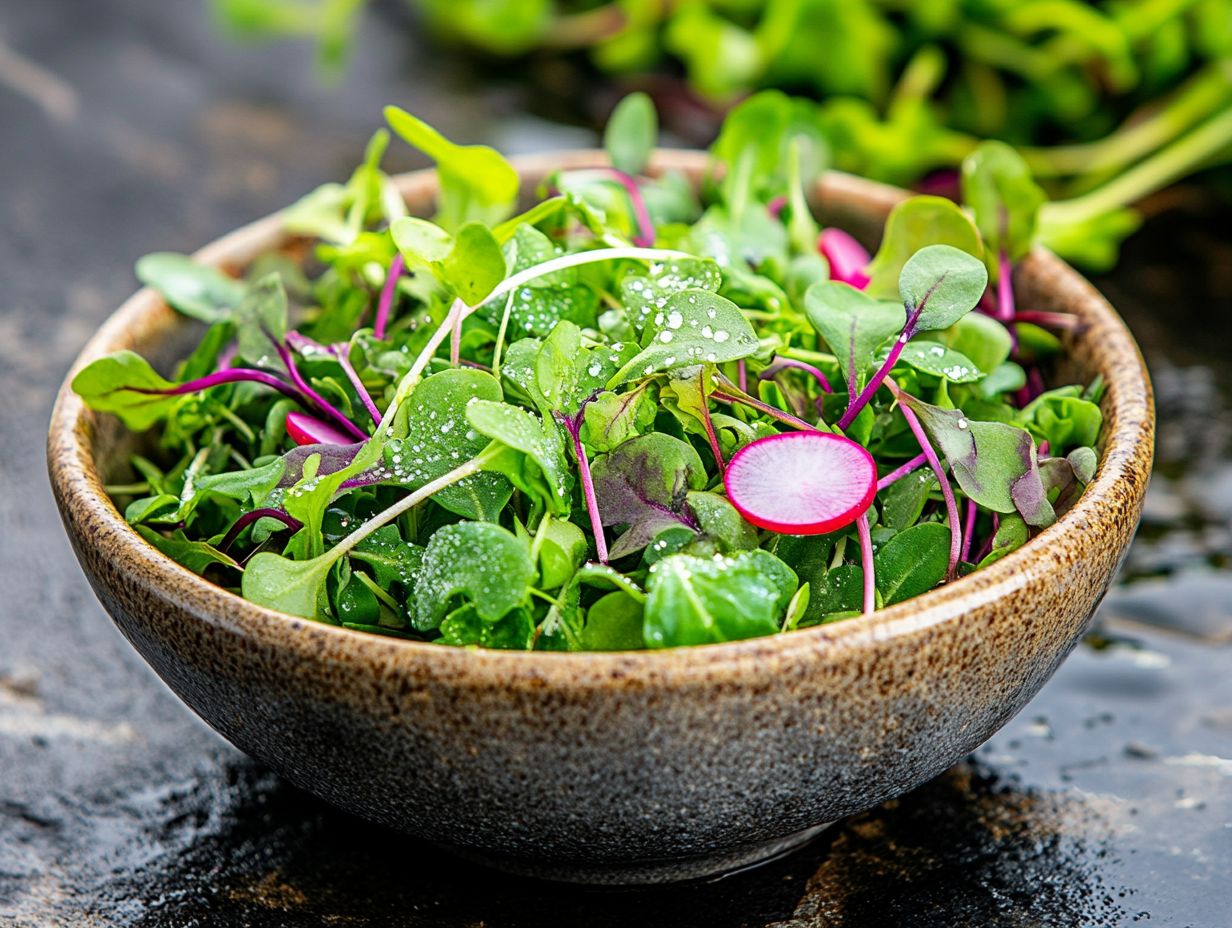
Microgreens elevate your salads, enhancing not just the nutrition but also the flavor and texture. They introduce potent mustard and peppery arugula for an exciting food experience. Varieties like peppery arugula and potent mustard infuse a delightful kick, while their vibrant colors and unique textures elevate the visual allure and overall taste of your summer salad.
Incorporating microgreens such as sweet basil or zesty radish into a simple mixed greens salad introduces contrasting flavors that are pleasing to the palate and the eyes. For instance, a blend of sunflower and pea shoots adds creamy crunch and creates a stunning green palette. If you’re wondering what seeds to use for microgreens, the spicy notes of daikon radish microgreens can be beautifully paired with milder greens like spinach, resulting in a well-balanced dish.
This combination transforms an ordinary salad into a food experience, unlocking endless possibilities for creative flavor pairings!
Choosing the Best Microgreens for Salads
Select microgreens based on flavor, health benefits, and growing conditions, especially for those focused on indoor farming needs.
Microgreens like kale, arugula, and pea sprouts stand out as exceptional choices, capable of enhancing both the taste and health benefits of your dish.
Factors to Consider
When you choose microgreens for your salads, consider important factors that can elevate your food experience. Think about their flavor profiles, health benefits, and growth conditions; these elements will greatly influence your dish.
These small yet vibrant plants do more than just add a splash of color; they bring unique flavors to the table, ranging from peppery and spicy, like arugula, to sweet and earthy, like beets. Nutrition is also key many microgreens contain higher concentrations of vitamins, minerals, and antioxidants compared to their mature counterparts, enhancing your overall well-being.
Understanding the cultivation methods, whether soil-based or hydroponic, can significantly affect their freshness and availability, impacting both flavor and health benefits. Incorporating microgreens seamlessly enriches your palate and nourishes your body!
Top Microgreens for Salads
Several microgreens emerge as premier choices for your salads, including kale, arugula, and pea microgreens, all known for their high nutrient content and delightful flavors. Each one brings its own unique flavors and textures, ready to elevate your culinary creations.
Incorporating these tiny greens into your meals does more than just enhance the visual appeal; it also injects a burst of nutrition. Kale microgreens, with their subtly peppery flavor, are brimming with vitamins A, C, and K, making them an ideal foundation for a hearty salad. Arugula microgreens offer a distinctive, spicy kick that complements citrus dressings or creamy toppings beautifully. Meanwhile, pea microgreens contribute a sweet, fresh flavor reminiscent of spring, perfect for those light, refreshing salads you crave! For those interested in maximizing nutrition, exploring the best microgreens for smoothies can be a great addition.
By tossing these vibrant greens into your salads, you introduce intriguing flavor dynamics while significantly boosting the nutritional profile. Make your meal not just delicious but also supportive of your health goals!
How to Grow Microgreens for Salads
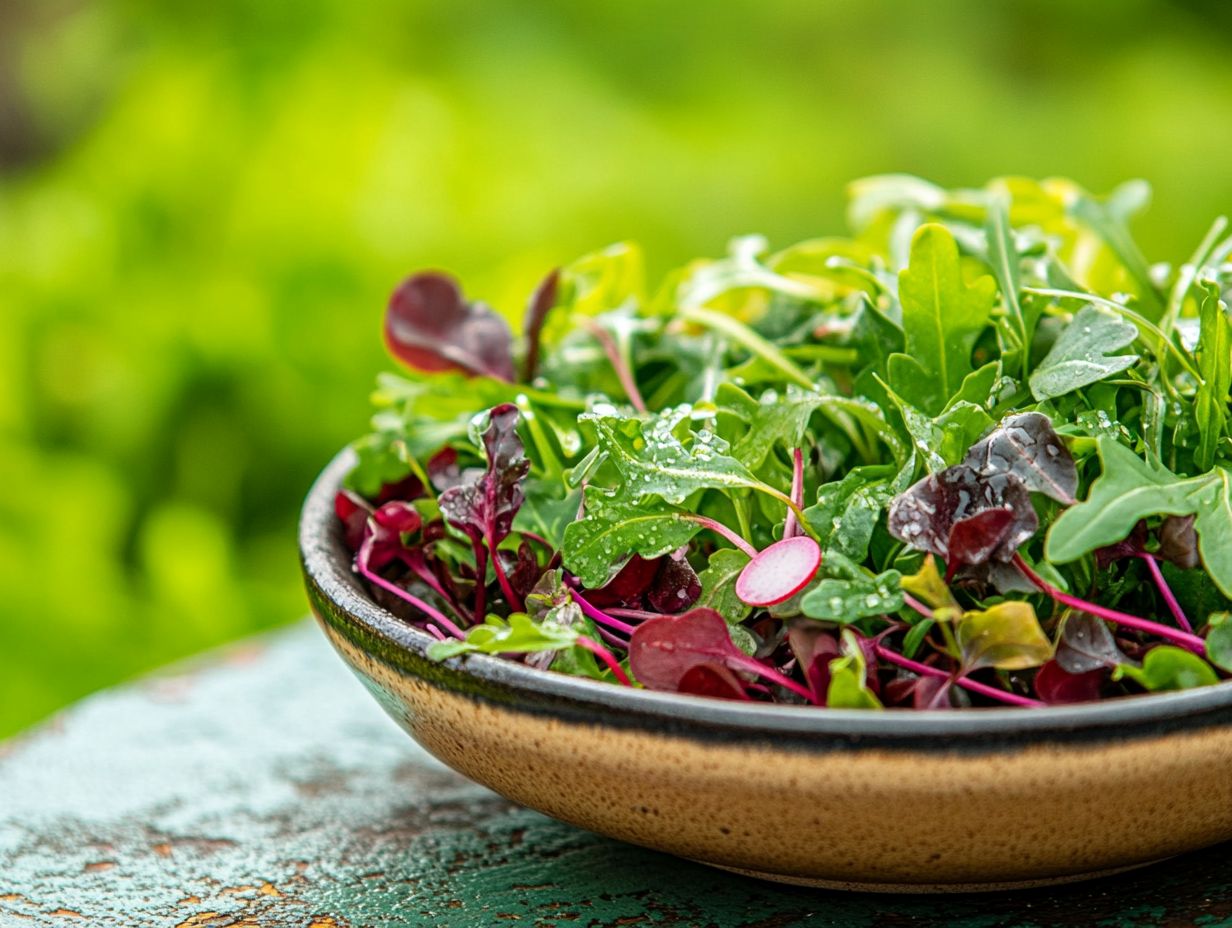
Growing microgreens for your salads is a truly rewarding experience that you can embark on swiftly and effortlessly, fulfilling your indoor farming aspirations. These fast-growing greens can be harvested in as little as 7 to 14 days, making them a superb option for your indoor farming aspirations.
Whether you’re a novice just starting or a seasoned gardener looking to expand your repertoire, microgreens offer an accessible and gratifying choice!
Step-by-Step Guide
To successfully grow microgreens, dive into this step-by-step guide for indoor farming. It focuses on selecting the right soil, getting enough light, and proper watering.
Understanding growing small plants is essential for success.
Begin by choosing a high-quality soil that drains well, such as a mix of peat moss and vermiculite. This encourages healthy root development.
Microgreens thrive with 12 to 16 hours of bright, indirect sunlight each day. If you don t have enough natural light, a grow light works well.
Keep the soil moist but not soggy. Overwatering can cause mold problems.
You may face challenges like aphids or damping off. Ensure good air circulation and use organic pest control to manage these issues.
With attention to these details, you can cultivate a thriving microgreens garden indoors, ensuring a continuous supply of these nutrient-dense plants.
Tips for Incorporating Microgreens into Salads
Adding microgreens to your salads boosts flavor and creativity. They transform summer salads into colorful, nutritious dishes.
Here are some insightful tips and inventive recipes to help you fully embrace the potential of these tiny greens.
Creative Recipes and Ideas for Health-Conscious Consumers
Explore a world of creative recipes and ideas to elevate your salads with microgreens, focusing on unique combinations and dressings that truly highlight their vibrant flavors.
These tiny greens bring color and a burst of flavor to your dishes!
Picture this: combining radish microgreens with crisp cucumbers and juicy cherry tomatoes to create a salad that bursts with color, all brought together with a zesty lemon vinaigrette for that perfect finish.
You might also consider pairing delicate pea shoots with creamy avocado, garnished with a sprinkle of sesame seeds for a delightful contrast. Or, elevate your presentation by adding arugula microgreens alongside roasted beets and tangy goat cheese, drizzled with balsamic glaze to enhance the flavor profile.
These suggestions illustrate just how versatile microgreens can be, transforming a simple salad into a gourmet experience that delights both the eyes and the palate.
Frequently Asked Questions
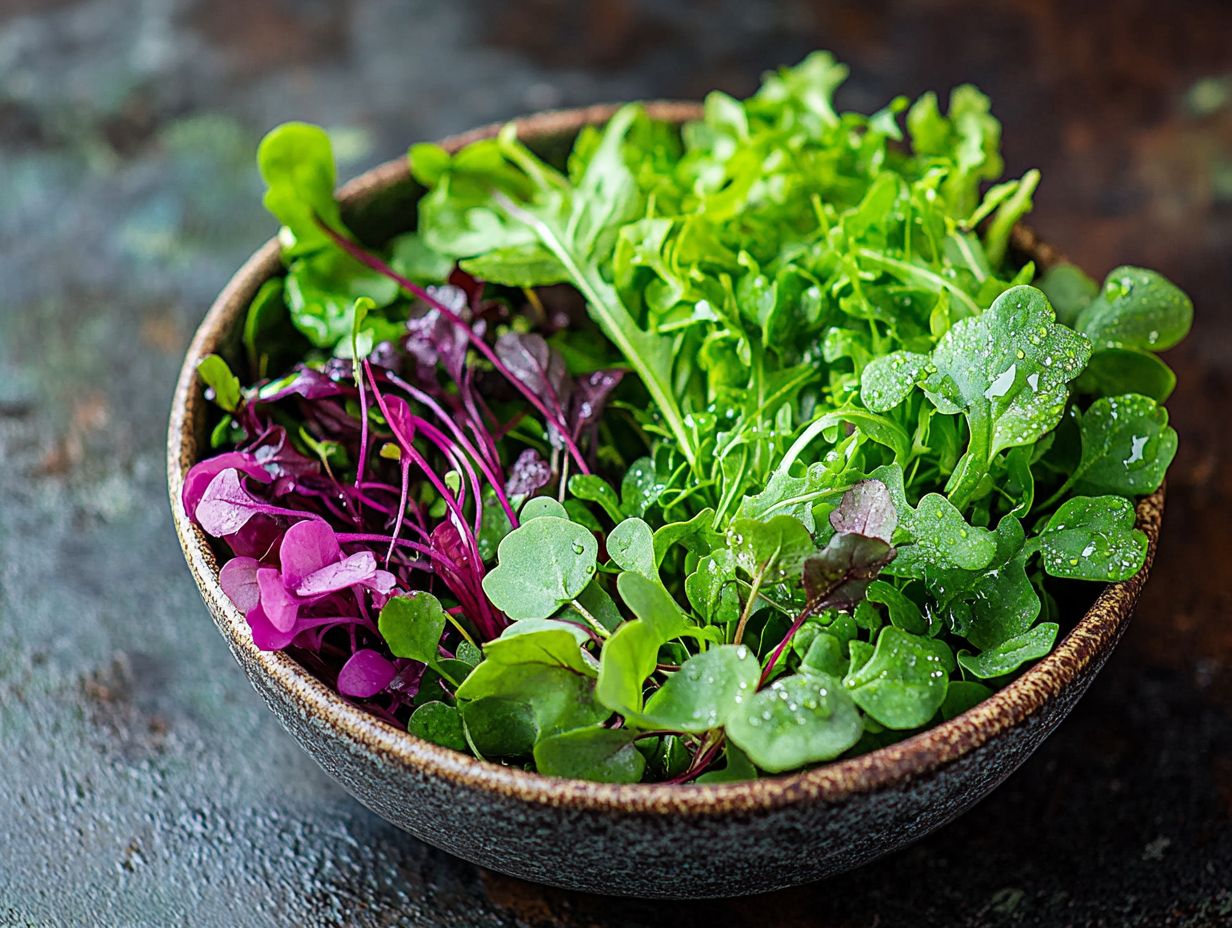
What Microgreens Are Best for Salads and Health?
Microgreens are tiny edible plants that are harvested at an early stage of growth, making them perfect for adding flavor and nutrition to salads.
Why should I add microgreens to my salads?
Microgreens are a great way to enhance the taste and texture of your salads. They are also packed with nutrients, including vitamins, minerals, and antioxidants.
Which microgreens are best for salads?
Some of the best microgreens for salads include arugula, kale, radish, broccoli, and sunflower microgreens. These varieties add a delicious crunch and flavorful punch to any salad.
Can I grow my own microgreens for salads?
Yes, you can easily grow your own microgreens at home. All you need is a container, potting soil, and seeds. With a little bit of time and effort, you can have fresh microgreens for your salads whenever you want.
Do microgreens have any health benefits?
Microgreens are considered a superfood due to their high nutrient content. They are rich in vitamins C, E, and K, as well as minerals like potassium and iron. They also contain polyphenols and other antioxidants that can help boost your immune system and protect against chronic diseases.
Can I mix different types of microgreens in my salads?
Absolutely! Mixing different types of microgreens can add a variety of textures, flavors, and nutrients to your salads. You can experiment with different combinations to find your favorite mix.

